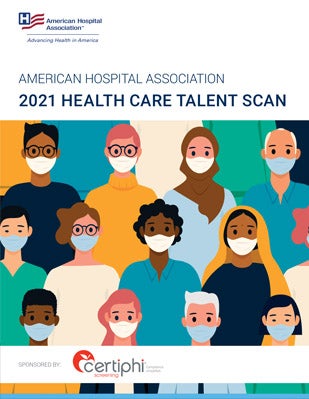

The Time to Address Workforce Planning and Resiliency Is Now

Faced with costs rising faster than revenues, shutdowns of nonemergent operations and treating a growing number of uninsured patients, hospitals and health systems have walked a staffing tightrope during the COVID-19 outbreak. Now, with the pandemic expected to continue well into 2021, provider organizations face workforce challenges ranging from training and retraining to finding the most effective ways to engage and protect staff.
 This will require reassessing issues like workforce resiliency, thinking innovatively about workforce shortages, transitioning to a team-focused operational care model and exploring ways to automate manual tasks with the help of tools like artificial intelligence, notes the AHA’s recently released “2021 Health Care Talent Scan.”
This will require reassessing issues like workforce resiliency, thinking innovatively about workforce shortages, transitioning to a team-focused operational care model and exploring ways to automate manual tasks with the help of tools like artificial intelligence, notes the AHA’s recently released “2021 Health Care Talent Scan.”
The report, based on a review of studies and data sources from leading organizations and researchers, provides executives with insights and information to guide their organizations forward during these uncertain times. Among the report’s guidance:
- Develop a deeper understanding of the relationship between clinical decision-making and the organization’s ability to take on risk. Shifting payment models and future uncertainty will affect hospitals’ ability to recruit, train and compensate health care professionals who increasingly will provide care in a variety of collaborative settings. Providers must be able to compete with nontraditional providers who seek to meet changing consumer expectations for more accessible, affordable and Amazon-like experiences.
- Make culturally competent, equitable, affordable access a workforce imperative for all people and communities served. Health systems must be prepared to meet the needs of a multicultural, multigenerational workforce and an increasingly diverse patient community. Workforce diversity supports higher racial and ethnic minority patient choice and satisfaction, while eliminating diversity disparities within health care settings, better engages communities and prioritizes diversity in leadership.
Reassessing workforce resiliency in the months ahead will be critically important as organizations continue clearing backlogs of nonemergency surgeries and services and brace for potential new surges of the virus. Immediate and long-term planning are crucial to prevent clinical and nonclinical staffing shortages from compromising surge capacity. With this in mind, it’s time to take emergency-response planning to the next level.
Building a strategically aligned, multifaceted approach to staffing on a hospital emergency incident command system (HEICS) foundation is vital to ensuring sufficient staffing levels and supporting redeployment as needed.
7 Workforce Planning Questions to Ask
- Will your staffing plan support your organization as it resumes delivering nonemergency services and surgeries?
- How quickly are you prepared to scale up or redeploy clinical and nonclinical staff in the event of a COVID-19 resurgence or other emergency, such as natural disasters like hurricanes, wildfires and floods that many parts of the country are experiencing?
- How efficient is your screening/onboarding process in ensuring the qualifications of new hires?
- When was your HEICS last reviewed?
- What other local, regional or state resources can you tap — including partnering with other hospitals or coordinating volunteer teams — to meet surge-capacity needs?
- Do you have a well-thought-out communications plan that includes a variety of strategies, such as regular town hall meetings to address furloughs, layoffs and redeployment?
- Will disruption to educational programs/residencies affect your future recruitment efforts?



